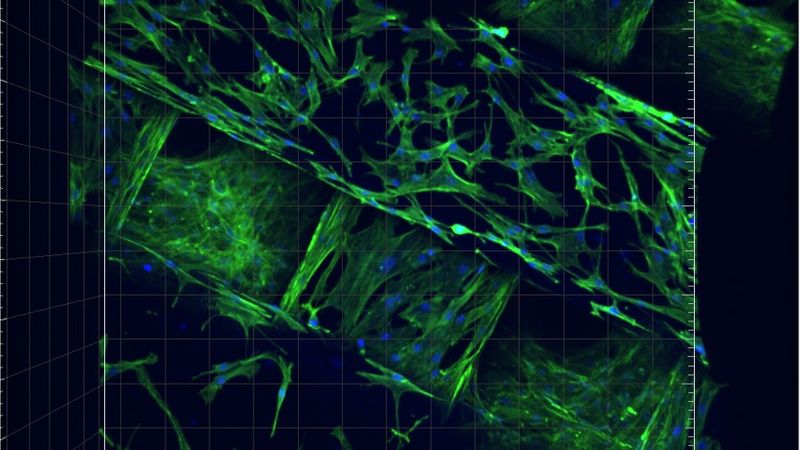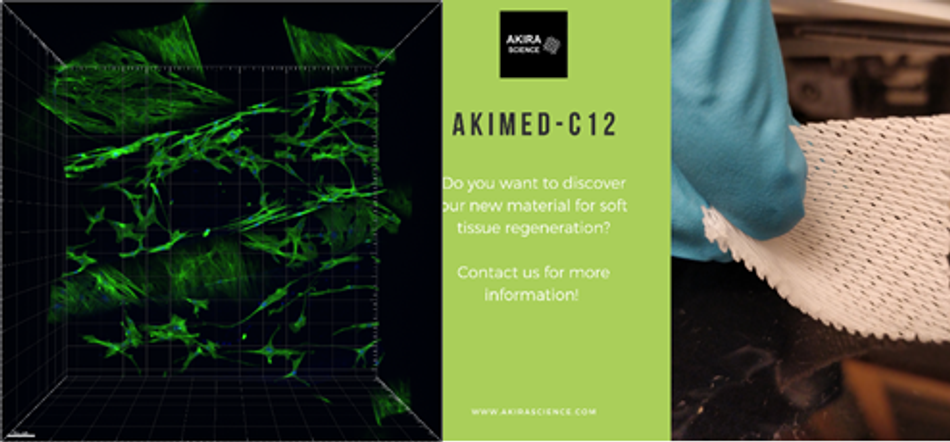Tissue Engineering and 3D Printing: Two Revolutionary Disciplines Now Fused Into One
“The nexus between two revolutionary disciplines is inspiring us towards a future improved society”

3D cell-scaffold interaction
Akira Science AB, a start-up based in Stockholm, is betting on the combination of two revolutionary disciplines: tissue engineering and 3D printing.
These two disciplines used to belong to two different stories that are now deeply interconnected. During the last fifty years scientists and surgeons have combined the concepts of life sciences, biology and biocompatible materials to construct functional tissues and open the way to innovative and less invasive techniques respect to traditional surgical transplants. They have been looking for new materials to substitute classical treatments to improve medical treatments where autograph or allograph of explanted tissues are required due to disease or trauma. In parallel to this story, 3D printing technologies also known as Additive Manufacturing (AM) were born in the 1980s and initially intended to quickly produce prototypes within industrial applications. When 3D printing technologies later met tissue engineering, a powerful combination consolidated to create structures with controlled geometry and high rate of reproducibility. Tissue engineers have been seeking for structures – scaffolds – that can provide structural and mechanical support to a damaged tissue while promoting its regeneration and allowing nutrients’ supply to the cells.
The 3D printing market has been growing fast during the last decade releasing innovative technologies and materials, especially for the medical sector. 3D printing is transforming the way we manufacture objects from a centralized to a decentralized, customized production onsite.
Akira Science is projected to have an active role in these future landscapes of smart and innovative manufacturing technologies applied to degradable materials for medical applications. The business potential arises from the ever-increasing need of patient-specific medical devices and of timely laboratory biological studies to test drugs and new clinical strategies - never so evident like in this pandemic period.
A cutting-edge new material and a smart scaffold design are the complementary and revolutionary points of force of Akira’s strategy. The newly developed polymer (AKIMed-c12) has exceptional thermal stability, ensuring control of the material properties while printing, presenting a faster degradation time in the body environment than the current utilized materials (from 3-5 years to 9-10 months). Although newly formulated, AKIMed-c12 is made starting from well-established building blocks for the synthesis of approved biomedical materials, ensuring biocompatibility and non-toxicity in the physiological environment. While the printed scaffolds are not hard as the current available ones, but soft and pliable proving comfort to the patient (AKIMed-c12: 3D printed scaffolds).
The new material will be the workhorse for the 3D printing of degradable medical devices, while the smart design opens the way to new applications in tissue regeneration that were not possible until today utilizing the materials available on the market. Akira team is confident that such a combination has the potential to expand the scope of degradable 3D printed scaffolds from hard, for example bone, to soft tissue regeneration, such as breast reconstruction after mastectomy.
Akira Science is providing both filaments for 3D printing and scaffolds with an architecture that satisfies customers’ need. Researchers and clinicians can buy the filament (AKIMed-c12: filament) and print the desired shape in their own facilities or can decide to ask Akira for printing their customized devices. Akira also provides support and consulting to collaborators and customers with material selection, design and simulation of the mechanical behavior of the desired scaffolds.
The company continues to invest in open innovation through a continuous dialogue with customers and by setting new strategies to map future needs in tissue engineering and 3D printing opportunities.
Álvaro Morales and Tiziana Fuoco (AKIRA Science AB)
